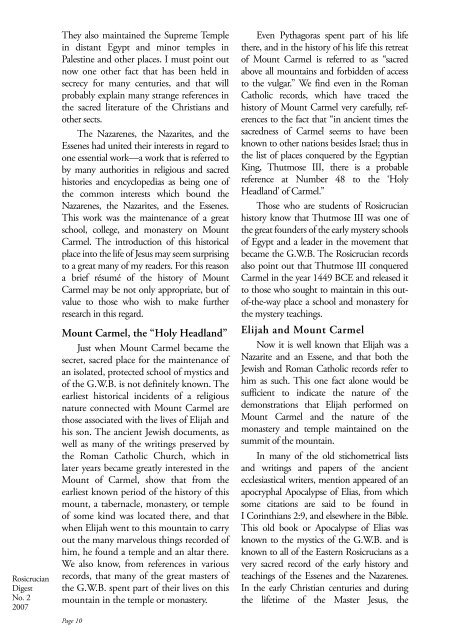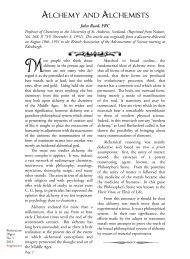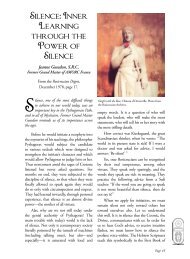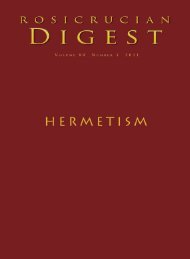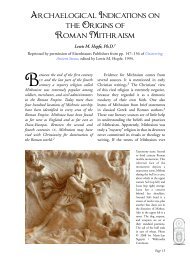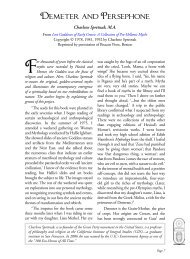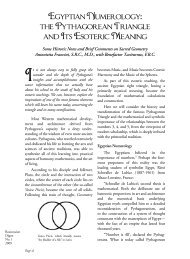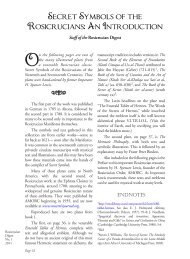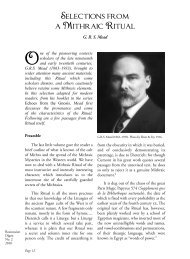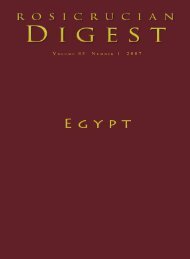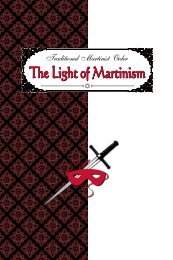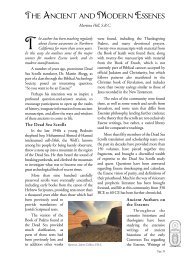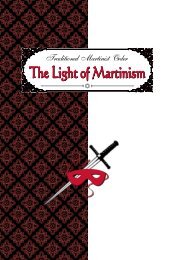Rosicrucian Digest Vol 85 Number 2 2007 - Rosicrucian Order
Rosicrucian Digest Vol 85 Number 2 2007 - Rosicrucian Order
Rosicrucian Digest Vol 85 Number 2 2007 - Rosicrucian Order
Create successful ePaper yourself
Turn your PDF publications into a flip-book with our unique Google optimized e-Paper software.
<strong>Rosicrucian</strong><br />
<strong>Digest</strong><br />
No. 2<br />
<strong>2007</strong><br />
They also maintained the Supreme Temple<br />
in distant Egypt and minor temples in<br />
Palestine and other places. I must point out<br />
now one other fact that has been held in<br />
secrecy for many centuries, and that will<br />
probably explain many strange references in<br />
the sacred literature of the Christians and<br />
other sects.<br />
The Nazarenes, the Nazarites, and the<br />
Essenes had united their interests in regard to<br />
one essential work—a work that is referred to<br />
by many authorities in religious and sacred<br />
histories and encyclopedias as being one of<br />
the common interests which bound the<br />
Nazarenes, the Nazarites, and the Essenes.<br />
This work was the maintenance of a great<br />
school, college, and monastery on Mount<br />
Carmel. The introduction of this historical<br />
place into the life of Jesus may seem surprising<br />
to a great many of my readers. For this reason<br />
a brief résumé of the history of Mount<br />
Carmel may be not only appropriate, but of<br />
value to those who wish to make further<br />
research in this regard.<br />
Mount Carmel, the “Holy Headland”<br />
Just when Mount Carmel became the<br />
secret, sacred place for the maintenance of<br />
an isolated, protected school of mystics and<br />
of the G.W.B. is not definitely known. The<br />
earliest historical incidents of a religious<br />
nature connected with Mount Carmel are<br />
those associated with the lives of Elijah and<br />
his son. The ancient Jewish documents, as<br />
well as many of the writings preserved by<br />
the Roman Catholic Church, which in<br />
later years became greatly interested in the<br />
Mount of Carmel, show that from the<br />
earliest known period of the history of this<br />
mount, a tabernacle, monastery, or temple<br />
of some kind was located there, and that<br />
when Elijah went to this mountain to carry<br />
out the many marvelous things recorded of<br />
him, he found a temple and an altar there.<br />
We also know, from references in various<br />
records, that many of the great masters of<br />
the G.W.B. spent part of their lives on this<br />
mountain in the temple or monastery.<br />
Page 10<br />
Even Pythagoras spent part of his life<br />
there, and in the history of his life this retreat<br />
of Mount Carmel is referred to as “sacred<br />
above all mountains and forbidden of access<br />
to the vulgar.” We find even in the Roman<br />
Catholic records, which have traced the<br />
history of Mount Carmel very carefully, references<br />
to the fact that “in ancient times the<br />
sacredness of Carmel seems to have been<br />
known to other nations besides Israel; thus in<br />
the list of places conquered by the Egyptian<br />
King, Thutmose III, there is a probable<br />
reference at <strong>Number</strong> 48 to the ‘Holy<br />
Headland’ of Carmel.”<br />
Those who are students of <strong>Rosicrucian</strong><br />
history know that Thutmose III was one of<br />
the great founders of the early mystery schools<br />
of Egypt and a leader in the movement that<br />
became the G.W.B. The <strong>Rosicrucian</strong> records<br />
also point out that Thutmose III conquered<br />
Carmel in the year 1449 BCE and released it<br />
to those who sought to maintain in this outof-the-way<br />
place a school and monastery for<br />
the mystery teachings.<br />
Elijah and Mount Carmel<br />
Now it is well known that Elijah was a<br />
Nazarite and an Essene, and that both the<br />
Jewish and Roman Catholic records refer to<br />
him as such. This one fact alone would be<br />
sufficient to indicate the nature of the<br />
demonstrations that Elijah performed on<br />
Mount Carmel and the nature of the<br />
monastery and temple maintained on the<br />
summit of the mountain.<br />
In many of the old stichometrical lists<br />
and writings and papers of the ancient<br />
ecclesiastical writers, mention appeared of an<br />
apocryphal Apocalypse of Elias, from which<br />
some citations are said to be found in<br />
I Corinthians 2:9, and elsewhere in the Bible.<br />
This old book or Apocalypse of Elias was<br />
known to the mystics of the G.W.B. and is<br />
known to all of the Eastern <strong>Rosicrucian</strong>s as a<br />
very sacred record of the early history and<br />
teachings of the Essenes and the Nazarenes.<br />
In the early Christian centuries and during<br />
the lifetime of the Master Jesus, the


